
By Celeste Ets-Hokin
What are native bees and why should we care about them?
As many of you Bee City USA blog readers may know, North America is home to roughly 4000 species of native bees, the premiere pollinators that are essential to the survival of at least three quarters of our region’s flowering plants. You may also be aware that the familiar and iconic honey bee (Apis mellifera), is not one of these bees! Honey bees, valued for their wax and honey, were brought to North America by European settlers in the 1600’s. Honey bees have since become integral to modern industrial agriculture.
But it is our V.I.P. (Very Important Pollinators!) native bees that ensure the healthy reproduction of the trees, shrubs and wildflowers that anchor America’s terrestrial ecosystems. Without native bees, these flowering plants would eventually disappear, and along with them the countless species of animals – from tiny birds to giant grizzly bears – that depend upon the plants for food and shelter. But as our natural and semi-natural areas have been steadily diminished by industrial farming and suburban development, native bee populations across North America have suffered alarming declines over the past several decades. The loss of habitat, coupled with pesticide poisoning, have already driven a number of species to extinction, and many others are threatened with a similar fate.
The good news is that we, as individuals from coast to coast, can offer many of our native bee species valuable habitat in our own backyards and community gardens. These adaptive pollinators are always on the lookout for urban and suburban real estate, and when you build it, they will come!
Have you been wondering about the best flowering plants to include in your bee-friendly garden and the different kinds of bees that each plant might attract? Now there’s an app for that! Get to know North America’s native bees and the plants they love – check out the new
Wild Bee ID website and app by Celeste Ets-Hokin and Center for Food Safety. Read the blog below to learn more about our native bees and the story of Wild Bee ID!What are native bees and why should we care about them?
As many of you Bee City USA blog readers may know, North America is home to roughly 4000 species of native bees, the premiere pollinators that are essential to the survival of at least three quarters of our region’s flowering plants. You may also be aware that the familiar and iconic honey bee (Apis mellifera), is not one of these bees! Honey bees, valued for their wax and honey, were brought to North America by European settlers in the 1600’s. Honey bees have since become integral to modern industrial agriculture.
But it is our V.I.P. (Very Important Pollinators!) native bees that ensure the healthy reproduction of the trees, shrubs and wildflowers that anchor America’s terrestrial ecosystems. Without native bees, these flowering plants would eventually disappear, and along with them the countless species of animals – from tiny birds to giant grizzly bears – that depend upon the plants for food and shelter. But as our natural and semi-natural areas have been steadily diminished by industrial farming and suburban development, native bee populations across North America have suffered alarming declines over the past several decades. The loss of habitat, coupled with pesticide poisoning, have already driven a number of species to extinction, and many others are threatened with a similar fate.
The good news is that we, as individuals from coast to coast, can offer many of our native bee species valuable habitat in our own backyards and community gardens. These adaptive pollinators are always on the lookout for urban and suburban real estate, and when you build it, they will come!

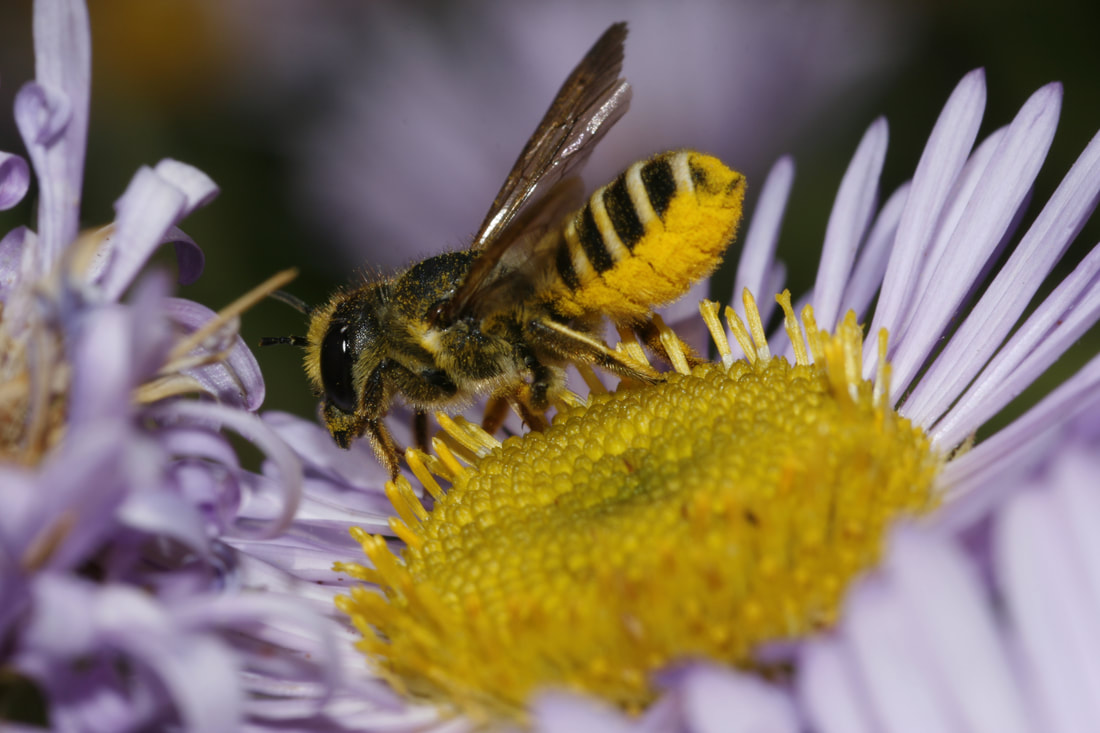
Use Wild Bee ID to throw the best garden party in town for native bees!
You might well be wondering: Just how do we throw the best garden parties in town for our native bees, and which of these diversely and often brilliantly attired guests are likely to accept our invitation? So glad you asked, because now there’s an app for that!
The newly released “Wild Bee ID” is not only a mobile app, available on both iOS and Android platforms, but is also a website – wildbeeid.org. With over 300 high resolution images of native bees and plants, Wild Bee ID is both a visually stunning and practical tool for the conservation of our native bees. This unique resource, that features electronic links between our commonly encountered North American native bees and the flowers they visit, is now free!
While not intended as an identification guide for individual bee species, Wild Bee ID rather provides you with an understanding and appreciation for the dazzling diversity of North American native bees; the tools to easily create habitat for them in our urban and suburban gardens; and tips on how to recognize these brilliant pollinators. In addition to detailed native bee and plant profile pages, the app includes an extensive narrative section presented as a set of guides, which introduces you to the essential world of native bees. The guides will help you learn to distinguish males from females, bees from flies and wasps; understand North American native bee ecology and taxonomy; and much more! All of the guides are illustrated with spectacular images of live native bees and their habitat, making WBID an excellent educational tool for students of all ages.
A tip of the App!
So how can you use Wild Bee ID to host the best garden party in town for our native bees and to recognize some of your V.I.P. guests? Here are a few tips from the app:
Tip #1: Celebrate Diversity! In order to attract a broad spectrum of native bee visitors to your bee-friendly garden, choose flowers with different sizes, shapes, and colors that will bloom in succession from spring through fall. Short-tongued bees are typically restricted to collecting pollen and nectar from open platform, composite flowers, while long-tongued bees will often seek the deep nectar rewards of tubular blossoms.
You might well be wondering: Just how do we throw the best garden parties in town for our native bees, and which of these diversely and often brilliantly attired guests are likely to accept our invitation? So glad you asked, because now there’s an app for that!
The newly released “Wild Bee ID” is not only a mobile app, available on both iOS and Android platforms, but is also a website – wildbeeid.org. With over 300 high resolution images of native bees and plants, Wild Bee ID is both a visually stunning and practical tool for the conservation of our native bees. This unique resource, that features electronic links between our commonly encountered North American native bees and the flowers they visit, is now free!
While not intended as an identification guide for individual bee species, Wild Bee ID rather provides you with an understanding and appreciation for the dazzling diversity of North American native bees; the tools to easily create habitat for them in our urban and suburban gardens; and tips on how to recognize these brilliant pollinators. In addition to detailed native bee and plant profile pages, the app includes an extensive narrative section presented as a set of guides, which introduces you to the essential world of native bees. The guides will help you learn to distinguish males from females, bees from flies and wasps; understand North American native bee ecology and taxonomy; and much more! All of the guides are illustrated with spectacular images of live native bees and their habitat, making WBID an excellent educational tool for students of all ages.
A tip of the App!
So how can you use Wild Bee ID to host the best garden party in town for our native bees and to recognize some of your V.I.P. guests? Here are a few tips from the app:
Tip #1: Celebrate Diversity! In order to attract a broad spectrum of native bee visitors to your bee-friendly garden, choose flowers with different sizes, shapes, and colors that will bloom in succession from spring through fall. Short-tongued bees are typically restricted to collecting pollen and nectar from open platform, composite flowers, while long-tongued bees will often seek the deep nectar rewards of tubular blossoms.


Tip #2: Go Native! One way to ensure that you are selecting plants that offer local pollinators a good source of pollen and nectar is to choose a variety of native plants for your garden. Studies have shown that native plants are at least four times more attractive than exotics to the native bees in a given region.
Tip #3: Avoid mulch madness! Did you know that 70% of our native bees are ground-nesters? These bees need access to bare, undisturbed ground. Try to leave areas of your yard free from a thick layer of mulch, as this prevents our ground nesting bees from excavating their nests. Once established, native plants shouldn’t need a thick layer of mulch, and areas where annual wildflower seeds are sown won’t usually present a barrier to ground-nesting bees. They will often find space to nest near the base of these plants.
Tip #4: ID your guests! A good way to know who’s coming to your garden party is to pay attention to the season in which they appear and the flowers they choose to visit. The emergence of native bees is often timed to their favorite floral resources. For example, mason bees (Osmia) emerge when orchard fruit blossoms appear in the spring. So when you see that shiny blue bee on your apple blossom, you’ll know it’s a mason bee.
Tip #3: Avoid mulch madness! Did you know that 70% of our native bees are ground-nesters? These bees need access to bare, undisturbed ground. Try to leave areas of your yard free from a thick layer of mulch, as this prevents our ground nesting bees from excavating their nests. Once established, native plants shouldn’t need a thick layer of mulch, and areas where annual wildflower seeds are sown won’t usually present a barrier to ground-nesting bees. They will often find space to nest near the base of these plants.
Tip #4: ID your guests! A good way to know who’s coming to your garden party is to pay attention to the season in which they appear and the flowers they choose to visit. The emergence of native bees is often timed to their favorite floral resources. For example, mason bees (Osmia) emerge when orchard fruit blossoms appear in the spring. So when you see that shiny blue bee on your apple blossom, you’ll know it’s a mason bee.
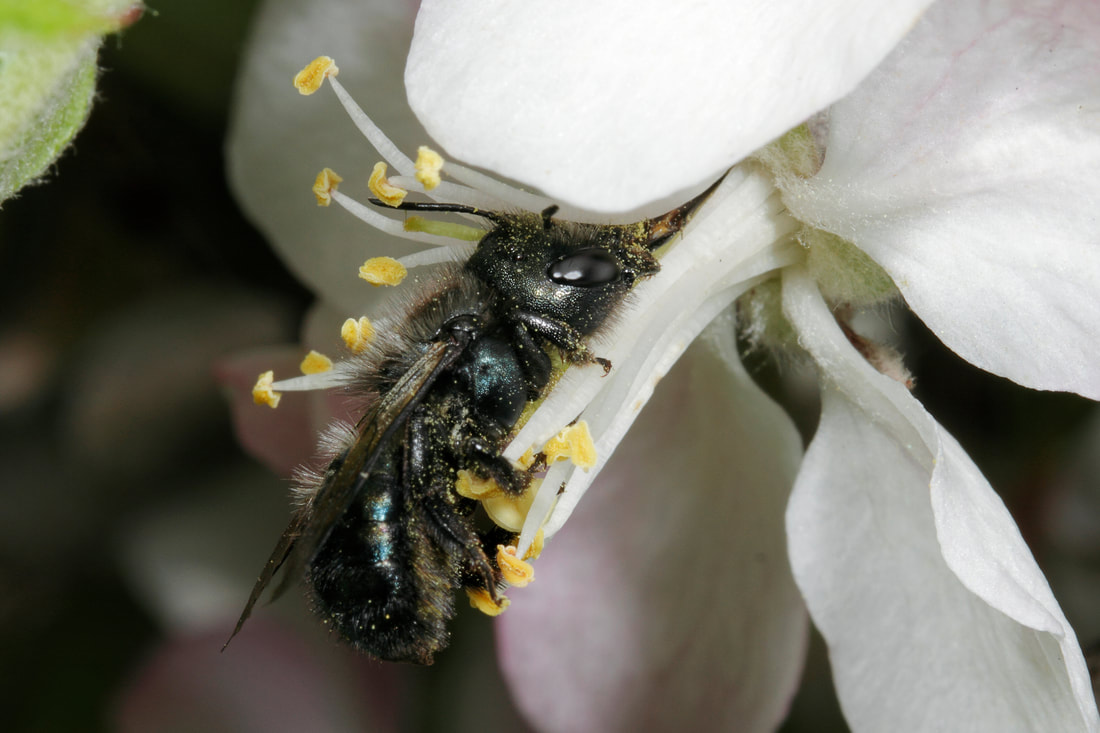
Or when you see one of your summer visitors wearing thick, elegant leg-warmers to your garden party, and enhancing this pollen-heavy attire each time she drops into a Cosmos, Helenium, Coreopsis, Gaillardia or sunflower, you can be pretty sure it’s a long-horned (Melissodes) female bee. And just where might the male long-horned bees be during all this industrious pollen-gathering on the part of the females? If they aren’t out chasing the females or drinking nectar from many of the same flowers, then you will often see them sleeping together in these flowers in the afternoon!


Some of our most colorful VIP guests should be issued frequent “flyer” passes, because, as multi-generational bee species, they can often be seen in our gardens from spring through fall. Who hasn’t enjoyed the first visits to our spring gardens by those elegant, fur-coated bumble bees, and observed that they’re some of the last guests to leave the garden party in fall? And it’s hard to take your eyes off of our brilliantly attired, phosphorescent green sweat bees, as they make their dramatic entrance in late spring, and don’t leave the party till summer’s end.

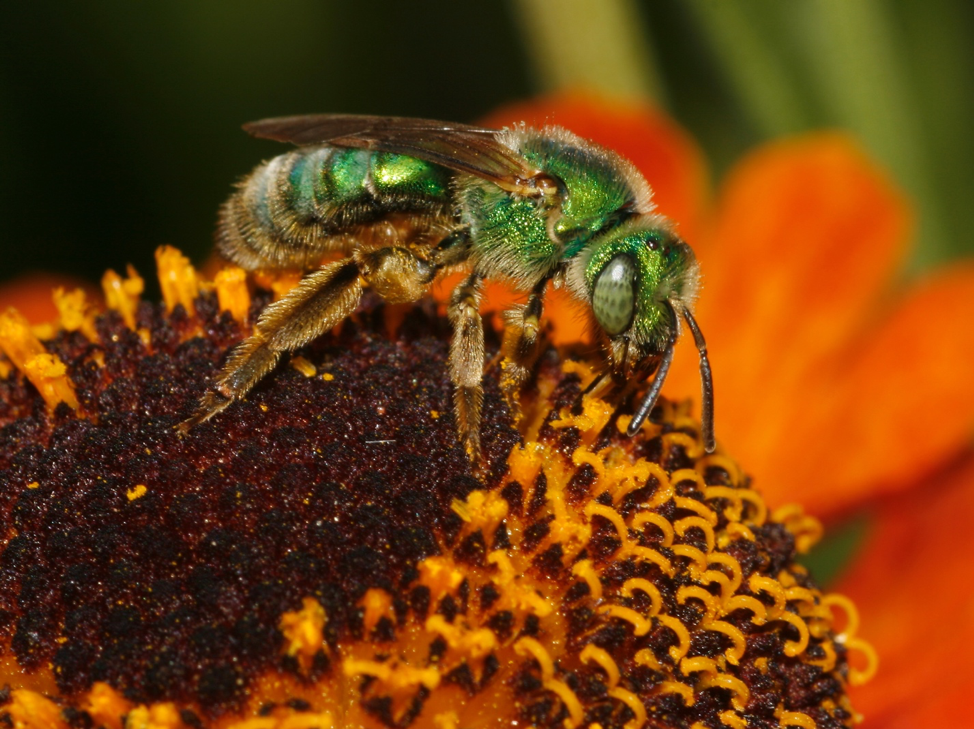
While you’re circulating among the colorful guests in your garden, you might be wondering which ones are males, and which are females? The WBID Guides can help you distinguish males from females (hint: it often comes down to bee-havior!) and bees from flies and wasps; and easily help you understand the various characteristics and relationships of our North American bees.
We hope then that you’ll download the app and provide us with your feedback or questions. In fact we’ve created an email account, exclusively for this purpose: [email protected]. Or just tell us about the best WBID plants where you live, and the native bee visitors they attract. If you send us app-quality native bee and plant photos, we’ll choose the best ones and add them to WBID. So let’s all get out in our backyard and community gardens this bee season and meet our colorful guests!
Get the free Wild Bee ID app today!
We hope then that you’ll download the app and provide us with your feedback or questions. In fact we’ve created an email account, exclusively for this purpose: [email protected]. Or just tell us about the best WBID plants where you live, and the native bee visitors they attract. If you send us app-quality native bee and plant photos, we’ll choose the best ones and add them to WBID. So let’s all get out in our backyard and community gardens this bee season and meet our colorful guests!
Get the free Wild Bee ID app today!
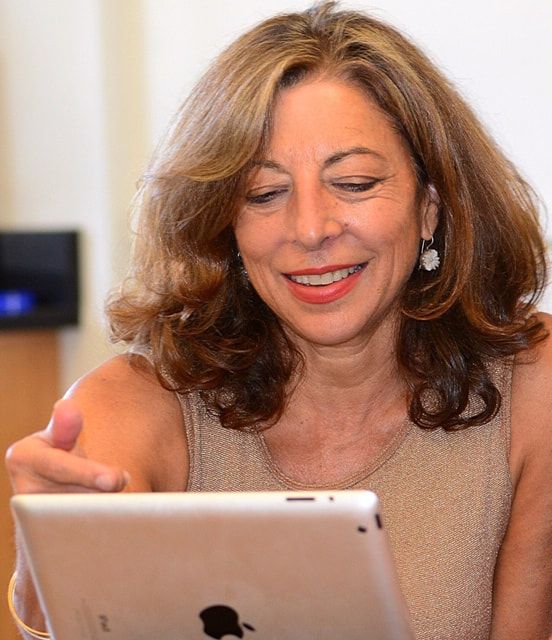
How did the Wild Bee ID author, Celeste Ets-Hokin, become native bee-dazzled?
As the creator of the Wild Bee ID content (formerly known as the Wild Bee Gardens app for iPad and iPhone), I’ll give you just a small glimpse into how this app came to bee:
As a Zoology graduate from U.C. Berkeley, I had an opportunity in 2008 to return to the field of environmental science. I had become alarmed by the reports of honey bee declines due to Colony Collapse Disorder (CCD), and how agricultural conditions across the country were contributing to this problem. So I completed two internships that year, one with the Environmental Working Group and one with Pesticide Action Network (PAN), hoping to eventually work on sustainable land use and pollinator conservation.
Towards the end of 2008, while working for PAN, I caught an article in Audubon magazine about UC Berkeley professor Claire Kremen’s work on native bees in agricultural landscapes. Since I had no prior awareness of native bees, this became a seminal moment for me—it focused my appreciation for the need to grow food and use land in a way that also provides forage and nesting habitat for pollinators. I wanted to help make this connection for others, and what better place to start than in my own backyard! And so I embarked on a journey of discovery through the fascinating world of native bees.
I happened to be at the right place and the right time to begin my education, as both Professor Claire Kremen and Professor Gordon Frankie, urban bee specialist, were right next door at UC Berkeley. And Professor Gretchen LeBuhn, founder of the Great Sunflower Project, was conducting her research across the bridge at San Francisco State University. Through Claire I learned about the Xerces Society, whose publications provided an invaluable education, and with whom I eventually collaborated on several projects.
Beginning then in 2009, I pursued a number of strategies to promote awareness about North America’s native bees, their vital role in our ecosystems, and the necessary measures to ensure their conservation. To support the work of The Great Sunflower Project and the Xerces Society, I created three consecutive North American native bee calendars, which were sold as a fundraiser for these conservation organizations. The calendar concept, which raised awareness about North America’s native bees and the flowers they visit, ultimately formed the foundation for the “Wild Bee Gardens” app.
In 2009, I also initiated a collaborative effort with the Alameda County Master Gardeners to establish a native bee demonstration garden located at The Gardens at Lake Merritt in Oakland, California. I approached Sam Foushee, the lead Master Gardener, and asked him if a portion of their trials garden area could be dedicated to a demonstration bee garden. He responded by saying, “Great idea, you’re in charge!” And so began a BEE-UTIFUL partnership.
Dr. Gordon Frankie’s experimental bee garden at UC Berkeley informed my plant selections at the Lake Merritt site. This bee garden is still blooming, buzzing, and attracting many human as well as native bee visitors! In fact it was in the Lake Merritt bee garden that I met a young couple who just happened to be wandering through one afternoon in 2012, and who ultimately became my app partners.
As the creator of the Wild Bee ID content (formerly known as the Wild Bee Gardens app for iPad and iPhone), I’ll give you just a small glimpse into how this app came to bee:
As a Zoology graduate from U.C. Berkeley, I had an opportunity in 2008 to return to the field of environmental science. I had become alarmed by the reports of honey bee declines due to Colony Collapse Disorder (CCD), and how agricultural conditions across the country were contributing to this problem. So I completed two internships that year, one with the Environmental Working Group and one with Pesticide Action Network (PAN), hoping to eventually work on sustainable land use and pollinator conservation.
Towards the end of 2008, while working for PAN, I caught an article in Audubon magazine about UC Berkeley professor Claire Kremen’s work on native bees in agricultural landscapes. Since I had no prior awareness of native bees, this became a seminal moment for me—it focused my appreciation for the need to grow food and use land in a way that also provides forage and nesting habitat for pollinators. I wanted to help make this connection for others, and what better place to start than in my own backyard! And so I embarked on a journey of discovery through the fascinating world of native bees.
I happened to be at the right place and the right time to begin my education, as both Professor Claire Kremen and Professor Gordon Frankie, urban bee specialist, were right next door at UC Berkeley. And Professor Gretchen LeBuhn, founder of the Great Sunflower Project, was conducting her research across the bridge at San Francisco State University. Through Claire I learned about the Xerces Society, whose publications provided an invaluable education, and with whom I eventually collaborated on several projects.
Beginning then in 2009, I pursued a number of strategies to promote awareness about North America’s native bees, their vital role in our ecosystems, and the necessary measures to ensure their conservation. To support the work of The Great Sunflower Project and the Xerces Society, I created three consecutive North American native bee calendars, which were sold as a fundraiser for these conservation organizations. The calendar concept, which raised awareness about North America’s native bees and the flowers they visit, ultimately formed the foundation for the “Wild Bee Gardens” app.
In 2009, I also initiated a collaborative effort with the Alameda County Master Gardeners to establish a native bee demonstration garden located at The Gardens at Lake Merritt in Oakland, California. I approached Sam Foushee, the lead Master Gardener, and asked him if a portion of their trials garden area could be dedicated to a demonstration bee garden. He responded by saying, “Great idea, you’re in charge!” And so began a BEE-UTIFUL partnership.
Dr. Gordon Frankie’s experimental bee garden at UC Berkeley informed my plant selections at the Lake Merritt site. This bee garden is still blooming, buzzing, and attracting many human as well as native bee visitors! In fact it was in the Lake Merritt bee garden that I met a young couple who just happened to be wandering through one afternoon in 2012, and who ultimately became my app partners.
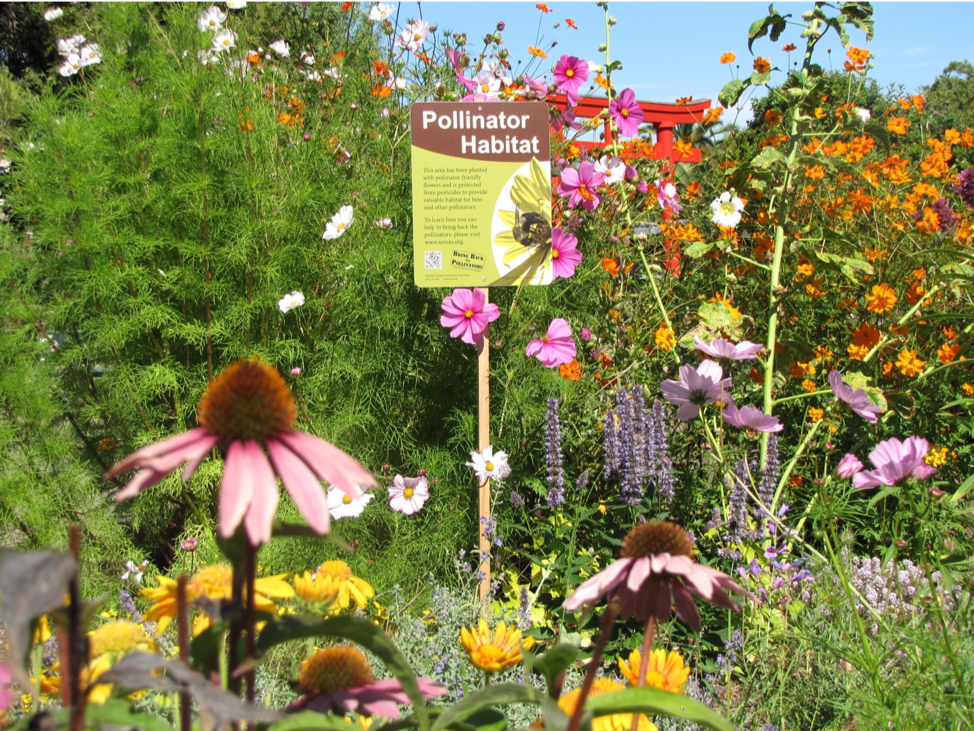
The couple fell in love with both the garden and the native bee calendars, and wanted to help me reach a wider audience. As luck would have it, he was an app developer for Apple platforms who was looking for a side project. He and his wife then helped me create an electronic, highly expanded version of the hard copy calendars, which was launched as the iPad app, “Wild Bee Gardens”, in 2014.
As I was responsible for writing all of the app content, I consulted with numerous UC professors during this nine month process, including Dr. Gordon Frankie, Dr. Claire Kremen and Dr. Robbin Thorp, Professor Emeritus at the UC Davis Department of Entomology. Dr. Thorp graciously reviewed the app in its entirety for scientific accuracy, and has since provided countless species identifications for our bee images and those submitted by the app user community.
In 2017, I transferred ownership of the app to the Center for Food Safety, an organization with which I had collaborated on several pollinator conservation projects. While its development took some time, CFS released the free version of my app, “Wild Bee ID” several weeks ago. All of the scientific content, spectacular photographs and basic navigation of the original app were retained in the new version, and now we want to let gardeners from coast to coast know about this accessible, free, and highly informative resource. Our goal is to put this unique conservation tool in the hands of more users, and make some real strides towards protecting our premiere native pollinators, one garden at a time!
Get the free Wild Bee ID app today!
As I was responsible for writing all of the app content, I consulted with numerous UC professors during this nine month process, including Dr. Gordon Frankie, Dr. Claire Kremen and Dr. Robbin Thorp, Professor Emeritus at the UC Davis Department of Entomology. Dr. Thorp graciously reviewed the app in its entirety for scientific accuracy, and has since provided countless species identifications for our bee images and those submitted by the app user community.
In 2017, I transferred ownership of the app to the Center for Food Safety, an organization with which I had collaborated on several pollinator conservation projects. While its development took some time, CFS released the free version of my app, “Wild Bee ID” several weeks ago. All of the scientific content, spectacular photographs and basic navigation of the original app were retained in the new version, and now we want to let gardeners from coast to coast know about this accessible, free, and highly informative resource. Our goal is to put this unique conservation tool in the hands of more users, and make some real strides towards protecting our premiere native pollinators, one garden at a time!
Get the free Wild Bee ID app today!
An initiative of the Xerces Society, Bee City USA’s conservation work is powered by our donors.
Your tax deductible donation will help us to protect the life that sustains us.
Your tax deductible donation will help us to protect the life that sustains us.




